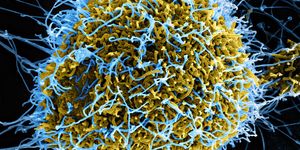
Researchers have long known that the color red evokes certain emotions in humans. They call it the "red effect." In the context of a social environment, or one in which mating is being considered (for instance, a Friday night at a singles bar) the color red evokes feelings of attractiveness. In an aggressive or competitive environment the color red will instill fear or anger.
The question has been why the red effect works. Is it result of repeated exposures in society or does it have a biological basis? Researchers from the University of Rochester sought to answer this question and their findings are significant in the study of behavior and its causes.
Benjamin Y. Hayden, a professor of Brain and Cognitive Studies at the University of Rochester, and Andrew J. Elliot a professor of Psychology, conducted a study with 1000 rhesus monkeys (Macaca mulatta) at a field site in Puerto Rico. The monkeys lived in a free-range environment and had sorted themselves into naturally formed social groups. For the study, researchers showed female monkeys three pictures of male monkey hindquarters. One of the pictures was framed in red, one in blue and one was not framed. The image of the hindquarters in all of the trials was printed in black and white. As a control, the monkeys were also shown photos of a common shell found in their habitat, also with red and blue frames as well as no frame color.
Hayden and Elliot chose primates because they share much of the same evolutionary history as humans, but of course have not been bombarded by advertising and images of strength and power often accented by the color red. They gauged interest by how long the monkeys looked at a particular image. When test subjects do not have language, the amount of time they gaze at something correlates to interest.
The study showed that female monkeys preferred to look at images of male hindquarters when they were framed in red. They showed no preference on images of the shell, regardless of the frame color. They also showed no particular preference for color when shown images of female hindquarters. The red effect was limited only to those images of males.
Researchers also recorded the interest of male primates in images of female hindquarters. Surprisingly, the males did not show a preference for any of the images, with or without the extraneous colored frame. This was likely due to the fact that in female primates, facial color as opposed to hindquarter color is what indicates their willingness to mate.
The study authors believe that this research points to a biological preference for color. Since the primates involved have never been exposed to the marketing of Valentine's Day or glossy magazine ads that use red accents to convey the image of victory and power, the desire shown for red likely has a basis in biology. The study is published in the journal Evolution and Human Behavior. Researchers said that more study is needed in this area to unlock how and why color influences behavior.
Image Credit: Vijay Anand Ismavel
 Researchers have long known that the color red evokes certain emotions in humans. They call it the "red effect." In the context of a social environment, or one in which mating is being considered (for instance, a Friday night at a singles bar) the color red evokes feelings of attractiveness. In an aggressive or competitive environment the color red will instill fear or anger.
Researchers have long known that the color red evokes certain emotions in humans. They call it the "red effect." In the context of a social environment, or one in which mating is being considered (for instance, a Friday night at a singles bar) the color red evokes feelings of attractiveness. In an aggressive or competitive environment the color red will instill fear or anger. 







